Where to go in Switzerland on a short trip: Alps, lakes, and cities
Switzerland is an extremely popular country for those planning multi-stop tours around Europe, yet very few potential first-time visitors actually know specifically where they want to go. Everyone seems to know that it has the most beautiful views of the Alps and some very impressive cities, but there are actually many misconceptions among casual trip planners, so I’d like to clear most of that up below. The places to visit in Switzerland are not obvious until you’ve been there yourself or done many hours of research, so the list below should be a short cut.
I get hundreds if not thousands of itinerary questions for people who are considering a Eurail trip around Europe, and most people just include the word “Switzerland” among a list of cities like Paris, Rome, and Berlin that they want to visit. So where in Switzerland should you go if you can only make a few stops at most? I’ll answer that question below. You’ll mostly want to focus on the best choices for Swiss Alps trips, which I’ll go over below.
Note: This article was expanded and updated in February, 2024.
Switzerland is about outdoor views rather than city visits
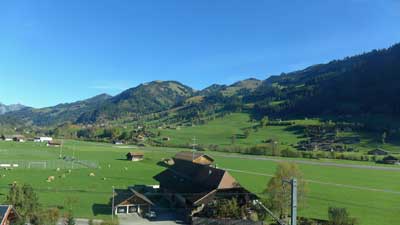
Geneva is a very famous city (though not for tourism reasons) on a lovely lake of the same name, but it’s also notoriously dull and lacking distinction. Rick Steves puts it well by saying that “Geneva is pleasantly situated on a lake, like Buffalo or Cleveland.” The point is, you don’t want to go to Geneva unless you’ve got something specific in mind that you want to see there. There are much better places to visit in Switzerland if your time is limited, or even if it’s not.
Switzerland's cities in summary
Zurich – The largest city, very expensive, geared towards business travelers. It’s generally a pretty and very well-run city that you would enjoy if you visited, but it’s not nearly as interesting as the likes of Vienna, Munich, or of course Paris.
Geneva – Second largest city, in the French part of the country, no major sights. Again, if you visited you’d be very impressed by it and get some great photos, but it’s not worth your time unless you know someone there. There’s an impressive fountain in the lake and you can usually see it from the train as you go through the city, but it’s not really worth going there and staying more than an hour or so.
Basel – Bordering France and Germany, no major sights. It has the famous art market each year, and aside from that it’s even duller than the ones above. Again, if you visited you’d be impressed, but if you later compared photos with friends who went to the Lauterbrunnen Valley instead, you’d kick yourself for going to Basel.
Lausanne – Near Geneva in the French part of the country, very hilly, and certainly more interesting than Geneva.
Bern – The capital, compact, on a lovely river, some interesting sights and the best Swiss city to get a feel for the culture. Bern is fairly close to Interlaken (which we will discuss below) and it can be a great day trip from there, especially on a day where it is foggy and/or rainy in the mountains (and this happens a LOT).
How much time and which Swiss cities to visit?
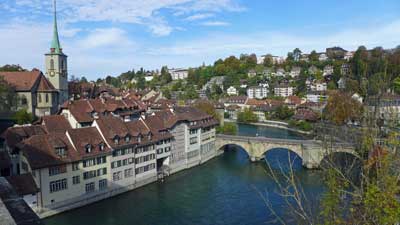
Many people (me included) don’t feel as if they’ve scratched the surface of a new country if they haven’t spent at least a day or two in the largest city. Zurich is certainly pleasant and a useful transit hub so spending one or two nights there wouldn’t be a major mistake. But Zurich isn’t even close to being a city like Paris, Rome, Berlin, Amsterdam, or even Vienna. If you skip it in favor of spending more time in the Swiss Alps, you won’t be missing much.
The 2 Best places to visit in Switzerland for short visits
Interlaken – If you want the best possible Alpine views and activities, head to the Interlaken area, which will be described in detail below. This is my favorite of all places to visit in Switzerland and it will probably be yours as well.
Lucerne – The traditional Swiss tourist retreat, Lucerne is a small city with interesting culture and sights, that is gorgeously set on a lake with plenty of top activities surrounding it.
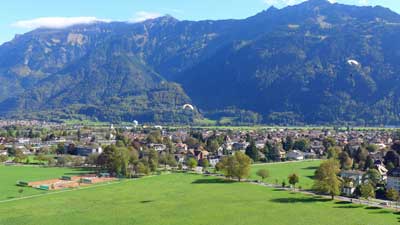
>>>Interlaken and Lucerne: Which to choose and how long to stay in each?
The article linked above will give you more details on which to choose and how long to spend in each place.
What about Zermatt for Alpine views?
Zermatt is a remote car-free village in southern Switzerland that is famous for being the place to see the Matterhorn mountain. It’s also a busy ski resort area, and aside from that, there isn’t much to see or do here. It’s on a private rail line, so it’s more complicated and usually more expensive to reach than Interlaken.
In other words, unless you’ve irrationally placed “Seeing the Matterhorn in person” on your so-called bucket list, skip Zermatt and head to Interlaken on a shorter visit. You won’t be sorry. If you already have enough time in your visit for the main sights around Interlaken and Lucerne and you want to also see the Matterhorn, then by all means go and you’ll enjoy it. There are quite a few other car-free villages in the Lauterbrunnen Valley near Interlaken, so they are not as novel in Switzerland as one might expect.
A weekend in Switzerland? What to see in 3 days
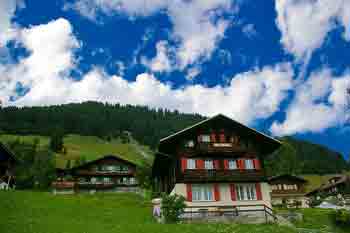
One challenge is that neither has an international airport so you’ll either be flying into Zurich or perhaps Geneva.
Train times from Zurich to Lucerne to Interlaken and back
- Zurich Airport to Lucerne: 1 hour 10 minutes by train
- Lucerne to Interlaken: 2 hours by train
- Interlaken to Zurich Airport: 2 hours 15 minutes by train
As you can see with the travel times above, Zurich Airport to Lucerne is a fairly short trip, but once you add Interlaken into the mix (even if you skip Lucerne) the travel time starts to add up for a weekend visit. With this in mind it’s probably best to just choose one of them and save the other one for another trip.
Lucerne is gorgeous, but the Lauterbrunnen Valley near Interlaken is really the star of the show, so I’d recommend going there first and doing Lucerne on another trip.
What about the Swiss Travel Pass?

The bottom line is that if you are coming to Switzerland for at least 3 days and you want to take 2 or more of the amazing scenic rail journeys that the country is famous for, the travel pass is probably a good deal. It also provides 50% discounts on the Schilthorn cable car and 25% off the Jungfraujoch mountain railway. Both of those are quite expensive on their own, but extremely worthwhile, so the discount is helpful.
The Half Fare Card is probably a better deal for most people
The Swiss Travel Pass is a good deal for those who are going to be spending at least 2 or 3 days riding the rails and seeing Switzerland that way. But if you are mostly going to be focusing on Interlaken and Lucerne and the mountain sights, the Half Fare Card is the best option. For CHF120 (about US$134) you get the card that is good for 30 days and gives you a 50% discount on all trains, cable cars, mountain railways, and other sights and attractions. If you are doing either Schilthorn or Jungfraujoch, the Half Fare Card practically pays for itself with just one of those.
>>>Buy the Swiss Half Fare Card
Many people have questions about the Swiss Half Fare Card so I will explain it a bit here. You can actually buy half price train tickets for travel within Switzerland any time you want and you will see that option when you go to buy them online. The only thing is you have to have and present a valid Half Fare Card when you get on the train and are asked to see your ticket. In other words, you can buy a half fare train ticket today and buy a Half Fare Card just before you get on that train months in the future, and you are fine.
How and why visit the area around Interlaken
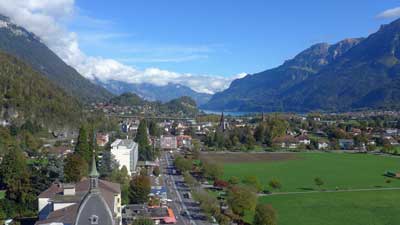
You can see everything discussed below by actually staying in a hotel in Interlaken, but it’s not the Alpine experience that you get if you stay in one of the small villages nearby. You can reach those villages in 20 to 40 minutes from the Interlaken Ost (East) train station, and it’s much easier than it sounds.
The 3 best places to stay to visit the Swiss Alps
Lauterbrunnen – A private train line runs from Interlaken Ost station to the end of its line in Lauterbrunnen. There’s a lovely waterfall here and great hiking trails, but you should probably only stay here if you can’t get to one of the villages mentioned just below. It’s a great little transit hub and it’s definitely gorgeous, so it can be worth a night if you’ve got one to spare.
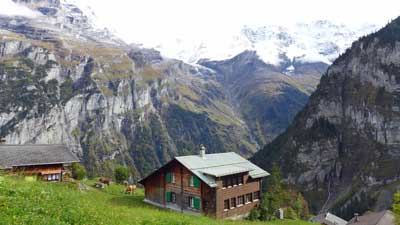
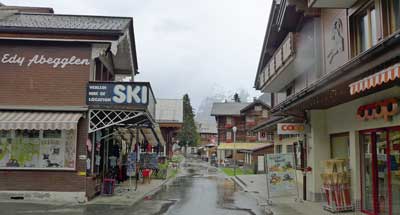
Where to stay in Interlaken and the Lauterbrunnen Valley (with pics)
I get so many questions about where to stay in the Interlaken area that I decided to write a longer version of it and load it with huge photos so readers can get a better feel for each option. I also included recommendations for affordable and well-located photos in each area.
>>>Where to stay in Interlaken and the Lauterbrunnen Valley New for 2024!
The unforgettable things to see here (if the weather is decent)
Schilthorn observation deck and restaurant
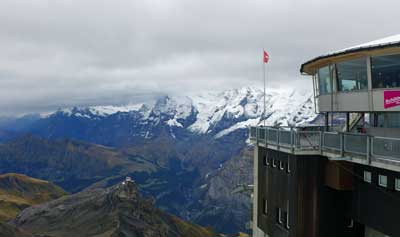
There is a rotating restaurant (with prices similar to normal Swiss restaurants) and a bizarre and anachronistic James Bond attraction based on it being a key location in the 1969 movie On Her Majesty’s Secret Service. The Bond thing is included with the lift, and it’s worth a look.
But the main thing you come here for is the 360-degree view from one of the highest peaks in Europe. Again, the weather here is key, but fortunately all the locals track the visibility on a minute-by-minute basis. If it’s clear up top while you are in the area, it would be a terrible shame to skip it based on the high price. But even if it’s cloudy up top, there are still plenty of wonderful things to see and do in the villages below.
Jungfraujoch observation area
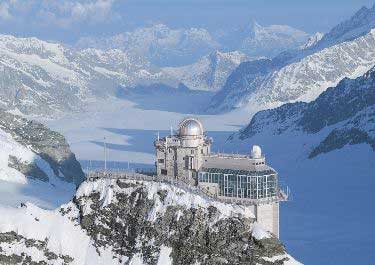
The views from the top are similar to the views from Schilthorn, from the other side of the Lauterbrunnen Valley. Once on top you can have lunch, hike, or even go sledding. It’s also quite expensive at nearly US$200 round-trip unless you have a Swiss Pass or a Eurail Pass for discounts, and it takes most of your day, but you’ll never forget the views from the top.
Harder Kulm mountain and Two Lakes Bridge Observation Deck
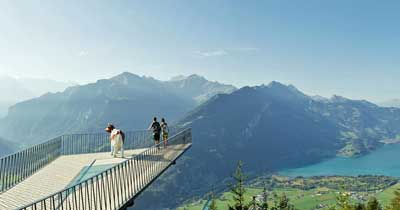
There’s a revolving restaurant about 10 minutes’ walk from the station at the top, which is definitely an unforgettable place for lunch if you’ve got time. It’s not as expensive as you might expect, at least compared to normal restaurants in Switzerland.
The Harder Kulm Railway goes from early April through late November each year. If you are only in Interlaken for one day and/or you are on a strict budget, this is the fastest and best way to get amazing Alpine views in the area.
Getting from Interlaken to Gimmelwald and Mürren
Getting up to these villages sounds complicated and time consuming, but it’s actually fast and easy once you get there. This little guide should help.
Arrive in Interlaken
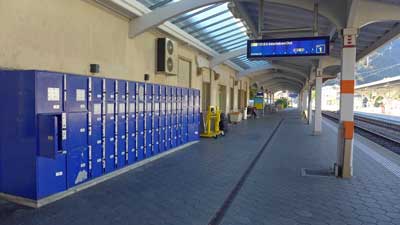
Once you arrive at the Interlaken Ost train station, head for the ticket windows in the office and buy a ticket to your final destination (Lauterbrunnen, Gimmelwald, or Mürren). Eurail passes are good for 25% discounts on the rest of the trip, but not for the whole thing.
From Interlaken Ost to Lauterbrunnen
The private train leaves Interlaken Ost every 30 minutes and arrives in Lauterbrunnen 20 minutes later. If you are staying in Lauterbrunnen then you are probably walking distance from your hotel when you reach the station.
From Lauterbrunnen to Gimmelwald
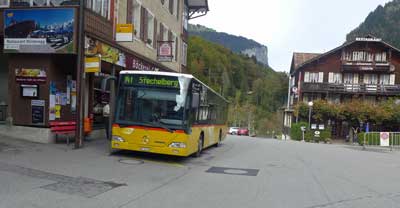

From
Gimmelwald to Mürren
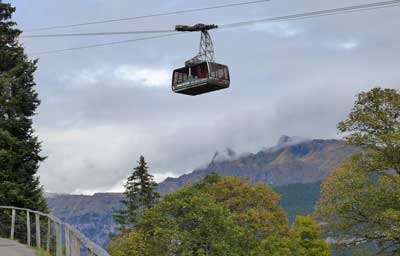
Recommended hotel and hostel in Gimmelwald
I get asked all the time about where to stay in Gimmelwald, so here it is:
Hotel: Esther’s Guesthouse
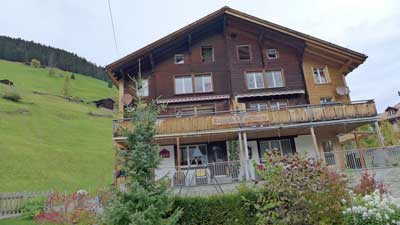
It’s run by Esther, as you might guess, and she is very friendly speaking excellent English. Each room is different and the place feels like a mountain cabin, because it is. She offers an excellent buffet breakfast in the morning, which you have to order the night before. It’s not cheap, but it’s worth it because it’s hearty and there are no other good options nearby.
Book as early as possible because this place is often the first place to sell out in Gimmelwald.
Hostel: Mountain Hostel Gimmelwald
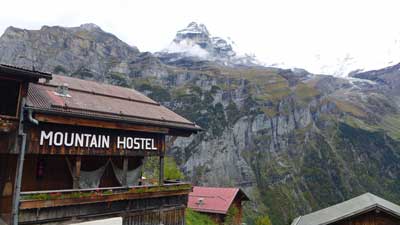
You won’t believe the views from this place, which are the same as from Esther’s except a bit lower and more unobstructed. This place also has a busy bar and restaurant that is basically the only “nightlife” in Gimmelwald. Many hikers get to bed early in this tiny village, but if you want to have a couple drinks and order a pizza or some local options, this is the place to go.
Again, book early because this place is always sold out.
Lucerne and what to do there
Luzern, as it’s spelled locally, is the other traditional holiday destination in Switzerland. Unlike Interlaken, Lucerne actually qualifies as a small city rather than a small resort town, so it’s a very nice contrast and very worthwhile. We have a new article with advice on where to stay in Lucerne and it should be helpful.
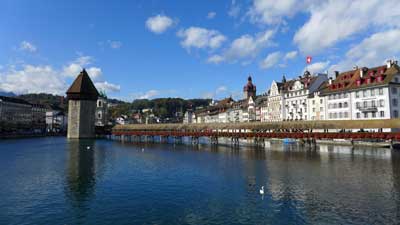
However, unlike Interlaken, the town of Lucerne itself is a great attraction and worth at least a day of exploration. This has always been a rich area so you can expect to find all of the high-end shops and boutiques along the small streets just north of the lake, but there are also many traditional shops and things to see that will appeal to anyone.
Recommended hotel in Lucerne
>>Hotel Des Alpes (3 stars with an amazing location and view)

If this place is booked, which is often the case, then book a hotel as close to it as you can find or afford. The whole historic part of town surrounding it is lovely, with restaurants, bars, and high-end shops. There are also a couple of nearby supermarkets where you can buy inexpensive alcohol and picnic supplies to keep other costs down.
Spend a day in Lucerne itself
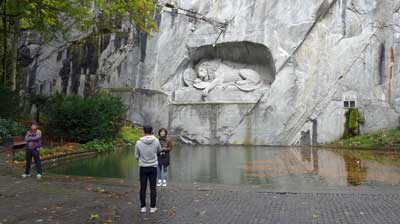
Most of the interesting part of Lucerne is in the area behind those restaurants, and it’s certainly worth doing a self-guided walking tour if not a guided one. Heading farther east you’ll come to another older part of town where the famous lion statue is located. You can’t visit Lucerne without having a look at the lion, and fortunately it’s easy and quick to reach (and it’s free).
Take a lake cruise of some kind
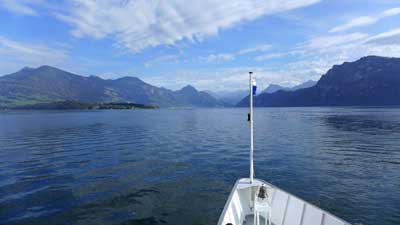
Especially in nice weather, even the short lake tour is lovely, and if you have more time you can jump off at Vitznau and do the scenic hike up Mount Rigi. There are also small lakeside villages that are ideal for a stroll and lunch stop. Long story short, there are dozens of interesting sightseeing options that are available using part of the boat tour, and the views all around are wonderful.
Visit Mount Pilatus
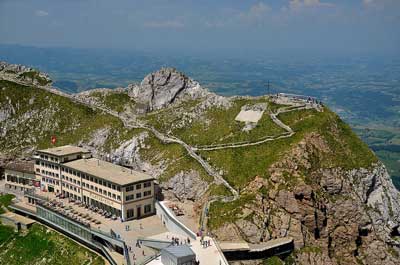
You can take the cogwheel train up and have a more or less flat hike around the summit area, and then take the gondola and cable car back down again. You can do them in the other order, and the cost is the same either way. At around US$65, this is not a cheap hike, but like most everything in Switzerland, the quality is high so it doesn’t feel like a rip-off. You can reach the cable car in 10 minutes on a public trolly bus from Lucerne.
Visit Mount Rigi
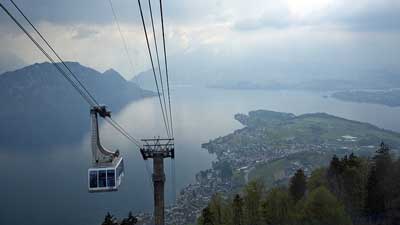
Unlike the other peaks mentioned in this article the Swiss Travel Pass covers both ways to get up and down for free. The others are 50% off with the Swiss Travel Pass or Half Fare Card, except for Jungfraujoch, which is only 25% off with the Swiss Travel Pass and still 50% off with the Half Fare Card.
Visit Mount Titlis
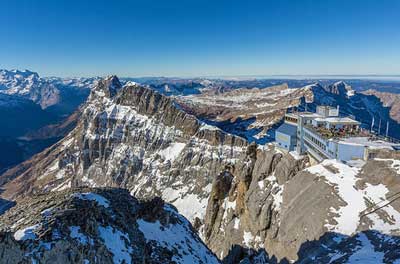
You can reach Titlis by taking a 43-minute train ride from Lucerne to Engelburg and then taking the cable car up from there. As with the others, it’s wise to check the weather immediately before you are going to depart because it can be foggy or cloudy any time of the year, but usually not for whole days at a time.
Additional photo credits
Jungfraujoch by cupweuro on Flickr, Pilatus by Tony Fernandez on Flickr, Rigi by Kosala Bandara on Flickr, Titlis by PaulSchliebs on Flickr

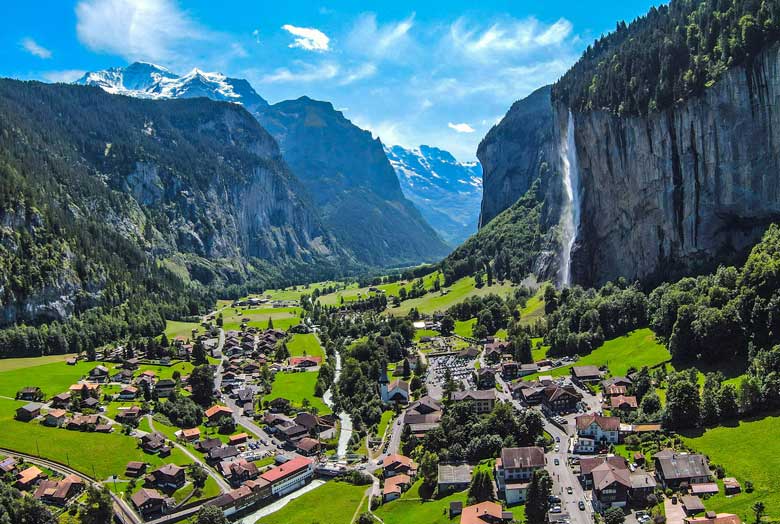
Roger,
Thanks for replying me i m talking about Germany, I will travel from wiesloch Walldorf Germany to Switzerland.
Suggest me if I should buy any travel pass or not?
Also tells me about Engelberg,
I have seen videos of Engelberg and Engelberg to titlis mountain cable ca adventure.
How’s this place is? and what is the ticket price of the cable car from Engelberg to titlis hill?
also, tell me about the guest card,
I have listened to this that I can avail some discount on guest card, so where can I get this guest card?
Faheem,
I think most of your questions are answered on my article on the Swiss Travel Pass. Most likely you won’t need a Swiss Travel Pass unless you are taking several longer train rides. For just the train from Germany to Switzerland it’s best to buy the ticket as far in advance as possible. And for the trains within Switzerland and the Titlis peak visit most likely you’ll be best off with a Half Fare Card. It’s all covered in that other article.
I’m not sure which guest card you are referring to, and I haven’t spent enough time in Engelberg lately to help you much with that either. Sorry I wasn’t of more help. -Roger
I m planning to visit Switzerland in mid of April, tell me about whether this day and also I want to share that I have only 2 days to visit Switzerland, I will be there in the weekend only,
1-kindly suggest me the best place to visit, I will travel from Wieloch.
2- Whats the cost I have to pay from Interlaken to Gimmelwald (Schilthornbahn). i meant cost of living for 2 days.
Faheem,
I don’t know where Wieloch is. The best place to visit for two days is the Interlaken area, so you are on the right track.
You’ll be able to get an idea about daily costs on our Interlaken prices page. Needless to say, the more top attractions you do and more restaurant meals you eat, the more expensive the trip will be. Switzerland is an expensive place, but it’s also filled with stunning scenery. Let me know if you have any other specific questions. -Roger
Roger,
Once again,many thanks for your advice. As I am now working out the finer details, I have a few more questions.
1) We will be using the Swiss public transportation system quite a lot and several times we will have to catch connecting trains. With a time lag of only a few minutes between the two trains, we have to change platforms and wait at the right spot to board the next train (we will be travelling 2nd class). This is where we are feeling a bit uncomfortable as we do not want to miss the connecting train as that would completely jeopardize our travel plans. We have no idea how big the stations are and how easy or how difficult it would be to change platforms within that time. I know the Swiss time table indicates track numbers, but not sure if that is correct all the time. We will have a very hectic day when we will travel from Interlaken to Zermatt early in the morning, ride Glacier Express all the way from Zermatt to St Moritz, and then return to Lucerne – all on the same day. GEX tickets, hotels are all booked accordingly. Also, we will have to take an early morning train from Lucerne to Zurich Airport on the day we return as our flight leaves at around 9am. Hence we must ensure that we do not miss any connecting train. Do you have any tips to offer that would make us feel confident and we will not miss the connecting train ?
2) When we are travelling by cable car or bus, and buying tickets on the spot, do we need to have exact change in CHF to pay for the fare ? If we have to pay cash (if credit card is not accepted), will the machine or the bus driver return the change if we do not have the exact fare ? Also will the half fare be applicable even for short bus rides and boat rides in Lucerne ?
3) If we have a ticket from one destination to another, can we get off at any of the stops in between, spend some time there and then board another train towards the destination ?
4) Two of us will be travelling and we already purchased our Half Fare Cards although our travel date is a month away. We would like to buy the train/bus/boat tickets online in advance for the routes that we must stick to (for Schilthorn and Jungfraujoch, we can wait until that day to buy the tickets as you advised). Should be buy two individual train tickets online or one ticket for the two of us ?
Will appreciate your valuable comments.
Regards,
Subrata
Subrata,
You’ll be happy to know that Switzerland is famous for its punctual trains, and way over 90% of the time they depart and arrive on time. The stations are all very well organized and signed, and as long as you have at least 5 minutes between trains at the big stations you should be fine. And at the smaller stations it’s often just walking across the platform onto the next train. If SBB.CH books you on a series of trains you can be almost 100% sure that it will be easy to make them.
Most people buy train tickets and such with credit cards these days, and every ticket booth or office takes credit cards. If you want to pay cash they can give you change. Switzerland is very modern and welcoming for things like this, and everyone you encounter in train stations etc will speak English. In almost all cases you can buy one ticket that covers your whole journey. So if it’s a train to another train to a bus to a cable car, you buy one ticket and then show that at each stage.
If you don’t have a reserved seat then you should be able to get off and get on the next train, but it might depend on the kind of train it is. If it’s a high-speed intercity train then you might have to ride the whole way on one train, but for suburban trains or commuter trains or tourist trains you can probably get off and back on.
If you are traveling together you should be able to buy two tickets and show that receipt when you get on board. I would wait to buy tickets to the peaks, as discussed. Buying tickets in advance is fine as long as you don’t have to commit to a particular departure time. The prices are the same if you buy a month in advance or 5 minutes before departure. Have a wonderful trip. -Roger
Hi Roger,
Thanks for your advice. I will change to 2 nights in Gimmelwald, 2 nights Interlaken and 2 nights in Lucerne.
By the way, how should we dress for this trip (end May to early of Jun)? Sorry for asking such question like this, i’ m from tropical country, this is my 1st time visit to place outside tropical area. And, any interesting local food to try?
Chee Woe
Chee,
How to dress is actually a very good question. In May and June it should be fairly warm on the valley floors and in the cities, somewhere around 20C to 24C. But as you go up the mountain it always gets colder and if you go to the top of Schilthorn or Jungfraujoch it will be a bit below freezing most likely, even that time of year. So the key is to dress in layers. Wear normal clothes in the valleys but bring a light jacket or sweater that you can put on and take off in the colder weather. You may even want to bring two layers, but chances are you’ll be moving around quite a bit and you won’t spend much time where it’s freezing, so one extra layer should be enough. And I hear all the time that people from the Tropics think they will get sick in the colder weather, but I don’t believe that is true.
The most common food in Switzerland is cheese and the classic dishes of the country are fondue, which is a pot of melted cheese that you dip bread or vegetables into, and Rösti, which is kind of a potato dish that also has cheese. I love both of those things and I love cheese, but I know cheese is uncommon in Asia and not everyone likes it. Honestly, the food of Switzerland might be the least amazing thing about the place, and there are really no dishes that you really HAVE to try. There are many Indian restaurants because they get so many visitors from India. Have a great trip. -Roger
Hi Roger,
I will visit to Switzerland together with my wife in end May’18. This is the 1st time we visit to Switzerland, therefore we was totally lose and don’t where to start. Until I found your article and I found it is very useful.
I will stay in Gimmelwald for 4 nights and 2 nights in Lucerne. And also I get ourselves Swiss Travel Pass. I will land and leave from Zurich.
Based on the details above. What places do you recommend us to visit during the stay? Is it possible for us to take Golden Pass for the journey from Zurich to Interlaken?
Thank you in advanced 🙂
Ho Chee,
I’m glad you found this article useful. First off, I’m not sure I’d recommend spending four nights in Gimmelwald. The location is absolutely stunning and the town is charming, but the town consists of only about 50 small farms plus a few hotels and restaurants. There is one path that goes through town and it takes less than 10 minutes to walk the whole thing before you are on your way up to Murren, which is a much larger village just above it. I might stay two nights in Gimmelwald and the other two nights in Interlaken or Wengen or Lauterbrunnen.
I included the top attractions in Interlaken and Lucerne in the article above, and I don’t like to give specific itinerary recommendations beyond that. You can find lists of other things to see in many other places on the internet.
The GoldenPass officially goes from Lucerne and through Interlaken to Montreux. The Lucerne to Interlaken section is nice, but the section through the valley to Montreux is even nicer. There are no panoramic carriages leaving from Zurich, so you’d have to change trains in Lucerne if you wanted to ride in one of those. I would just take the normal trains and enjoy the amazing scenery along the way. Once you leave the Zurich area you’ll find that the scenery in Switzerland is beautiful everywhere the trains go. Have a great trip. -Roger
Hi Roger,
Thank you very much for your suggestion. My doubt for the train ticket has been cleared. Would like to clarify some more.
– Is there any limitation on the baggage size and weight for all the train within Switzerland and From Venice to Interlaken and from Interlaken to Paris?
– For the Half Fare Card, I can buy it when I reach Venice is it and book the trip from Venice to Interlaken at the same time?
– Any recommendation for the place to stay in Interlaken and lauterbrannen?
Thank you.
Your help is greatly appreciated.
Nang,
There is no official limitation on baggage size or weight on those European trains, but you do have to be able to carry and lift them yourself. If you have one of those large wheelie bags and have a hard time lifting it over your head you can usually find someone to help you, though there are no baggage handlers as such.
For international train tickets it’s best to book them as early as possible for the lowest fares, and hopefully two or three months in advance. If you buy it on the Swiss Rail website you should be able to get a discount on the part of the trip that is within Switzerland. When you book that ticket it should ask you if you have any discount cards and you pull the little slider down to Half Fare Card. You can buy the actual Half Fare Card at any time, as long as you have a valid one with you by the time you board the first train. You can even buy one online and print it at home, and then get it validated once you get on your first train. There is no delivery charge if you buy it and print it at home.
My recommendations for where to stay in the Interlaken area are in the article above. If you can spare one or two nights to stay in Gimmelwald or Murren you will love it. If not you could stay in Lauterbrunnen or near one of the two Interlaken train stations. I don’t have any specific recommendations for those, aside from trying to stay fairly close to the station for a shorter walk. Have a great trip. -Roger
Roger,
We will be spending 5 days in Switzerland from April 09 to April 13. We will spend the first 2 days at Interlaken area, 3rd day travelling by Glacier Express and the last 2 days at Lucerne.
We have the choice of spending the first night either at Wengen or Murren. We expect to reach Interlaken around 11am on day 1 and wish to see Schilthorn, Wengen/Murren (depending on where we are staying) and Gimmelwald. We wish to do the circuit if possible – from Lauterbrunnen to Grütschalp (cable car), Mürren (cogwheel train), Gimmelwald (cable car), Stechelberg (cable car), Lauterbrunnen (bus). Trying to figure out how long completing this circuit will take. The next day we wish to see Jungfraujoch and Grindelwald and return to Interlaken in the evening. Not sure if it is worth getting off at Kleine Scheidegg and explore the place for some time and catch the next train.
Is it doable or we should consider some other plan instead ? What will be your recommendation to spend the first night at based on our wish plan – Wengen or Murren ? Should we buy tickets to Schilthorn and Jungfraujoch in advance ?
At Lucerne we will have 2 full days and wish to explore the city and some scenic places including a lake cruise. Unfortunately we will miss the cogwheel train ride to Mt Pilatus as it will not be operational at that time. Is it worth seeing all – Pilatus, Titlis and Rigi ? Is there a way to combine a lake ride (including seeing a few villages) and some mountain tops on our own (without going for a conducted tour) ? Do you recommend buying tickets in advance ?
I value your advice and it would be great to hear from you.
Regards,
Subrata
Subrata,
Your plan sounds great and I am not sure how long that circuit in Interlaken will take, but I’d guess it will take most of the day, especially since the scenery is so gorgeous that you won’t want to rush around too quickly. Hopefully the weather will cooperate.
I would stay in Murren if you can on that first night. Wengen is a really lovely village deep in a valley that is surrounded by those mountains, and Murren (and Gimmelwald) is a similar village that is actually halfway up one of those mountains so the view is just amazing. You don’t want to buy those peak attraction tickets in advance. It’s important to know that there can be clouds or fog or rain at the tops of those mountains on any day of the year. Often they are clear in the morning and foggy in the afternoon, and the systems tend to move through quickly so it’s rare that it’s foggy up there all day. There are webcams at the top of all of those places and locals keep close track of the daily weather, so the best thing to do is to plan on doing those things as early in your trip as possible and go as soon as you know it’s fairly clear up there. There is no point in even going to the top if it’s foggy up there, and so almost everyone buys their tickets just before they leave. The Jungfraujoch trains leave throughout the morning, and the cable car up to Schilthorn goes every 30 minutes all day, with the capacity of about 60 people at a time.
The mountain views over Lucerne are a bit less dramatic than the Interlaken ones, so there is no need to try to do all of them. You can visit Mt Rigi as part of the boat cruise where you get off the boat and then go up by cable car and then down by train. You don’t need to book a tour and you can buy your tickets as you go for that as well. Again, you want to check the weather before you go up. Let me know if you have any other questions. -Roger
Dear Roger, I have contacted you last year June and we made our trip with friends to Switzerland in Oct, 2017. Now I am planning for a trip with my family along with my sister & brother’s family in the month of June, 2018. We are a group of 9 adult 1 teenager and 1 kid (4 years). Which is the cheapest way of making a Junfraugh trip from Interlaken? Please help…
Girish,
If you are referring to the Jungfraujoch railway, there is only one way to get up there and the prices are fixed. The only thing you can do is buy a Half Fare Card for each adult, which costs CHF120 and gives each person a 50% discount on Jungfraujoch and every train, boat, and cable car in Switzerland for 30 days. Jungfrau is expensive and you almost pay for the Half Fare Card with just that one trip, and then everything else is 50% off from then after. You can see the Jungfrau peak very nicely from the top of the hill behind Wengen, which is reached by a fairly cheap cable car leaving from the middle of town. But as far as getting to that train station high in the Alps, the only way is to take the specific tourist trains that go up there. Best of luck on this. -Roger
Hi Roger,
I have read your information and feel impressed.
I need help to plan my trip as follows on early October:
Rome -> Venice ->
Zurich -> Interlaken -> Lauterbrannen -> Jungfraujoch ->
Paris
Please kindly suggest which pass from one place to one place will be suitable and cheaper for my trip from Zurich -> Interlaken -> Lauterbrannen -> Jungfraujoch.
Is there any pass that i can use in all three countries including train to Junfraujoch?
Please kindly suggest in details.
Your help is greatly appreciated.
Thanks,
Nang
Nang,
I’m not 100% sure what you are asking, but I’ll try to help. For the Rome to Venice trip just buy the train ticket 2 or 3 months in advance and it will be quite cheap. From Venice I would skip Zurich and just go straight to Interlaken because Zurich is kind of a dull city and it’s out of the way for you. Zurich is also incredibly expensive. For your train trips within Switzerland you’ll want to buy the Half Fare Card, which I discuss in detail in the article about the Swiss Travel Pass. It costs CHF120 per person and gives you a 50% discount on all train trips and boat rides and cable car rides in Switzerland for 30 days. You can also use it on your ticket from Venice to Interlaken and your ticket from Interlaken to Paris if you book on the sbb.ch website, which is the official Swiss Rail site. The Half Fare Card also gives you a 50% discount on the tourist train up to Jungfraujoch. Let me know if you have any other questions. -Roger
Hi Roger,
Hats of to you. I admire your patience in answering all the questions posed by the readers. You are doing a wonderful job 🙂 In fact, your site is the only site I could find which clearly outlines what to see and what won’t hurt to miss.
I am planning to travel with my wife and 2 kids (11yr & 7yr) to Switzerland around July. I am planning a 3-4 day trip and still finalizing my itinerary. Appreciate your help on the same.
I have a tight budget and only 3-4 days. Am seriously considering your recommendation of skipping the big cities and going to only Interlaken and Lucerne.
Queries:
1. What would be the closest international airport to reach these 2 areas? If I have no choice but to land in Zurich/Geneva then I might as well spend a day there.
2. Would these areas be suitable for kids? As in the altitude?
3. Would some of these areas have snow during July? Would be a shame to travel to Switzerland and not see snow? It’s very important for us as we have never seen snow before. Would love to have the kids play with snowballs.
4. I believe its summer at that time so we wouldn’t need very warm clothes?
5. What summits/mountains do you recommend to see which would be close by?
6. Could you recommend any places to stay as a family which serves breakfast; small budget?
7. I am hoping to do one train journey & cable car ride during this trip. Guessing the half pass would be good for this?
8. Any other recommendation from your side.
I know its a lot of queries but would appreciate your input.
Thanks
Stan
Stan,
Thank you for the kind words, and I’m happy to try to help.
1. Zurich Airport is closer to Interlaken and Lucerne, and it usually has more flights and cheaper fares as well. There is a train station at the airport, so you can go directly from the airport to Lucerne or Interlaken without having to change trains in Zurich itself.
2. Yes, the Swiss Alps are very popular with families and kids of all ages. The altitudes of the highest peaks isn’t an issue for most people except for perhaps popping your ears a few times. They aren’t high enough for altitude sickness as far as I’ve ever heard.
3. There is snow all year round at the top of Jungfrau and Schilthorn, but there won’t be snow at any lower elevations. You can play in the snow a bit in both places. Unfortunately, those are both expensive places to reach, although it’s worth it because they are also the most beautiful viewpoints in all of Europe.
4. Correct. It will obviously be cold at the highest peaks, so you’d want to bring a jacket along, but it will be warm in the valleys and fairly warm even in the mountain towns part way up the mountain such as Murren and Gimmelwald.
5. The two big sights are Schilthorn and Jungfraujoch, which are both discussed in the article above. They are both expensive, but worth it. Schilthorn takes less time to reach by cable car compared to the train going up to Jungfraujoch, but Jungfrau is a bit higher. The Half Fare Card will give you 50% off the fare of either one, and if you get a Swiss Family Card for free when you get there the kids can join you for free as well.
6. It’s nearly impossible to find a small budget hotel in Switzerland, and breakfast won’t be cheap either. You can probably find a reasonably priced hotel in Interlaken that serves breakfast, but it might be worth it to pay a bit more to stay in Murren or Gimmelwald or Lauterbrunnen or Wengen (all mentioned above) because those have much more beautiful views and locations, and they are already part of the way up the mountain. In other words, if you are staying in Murren it’s cheaper to get to Schilthorn because you are already two stops up the mountain.
7. Yes, the Half Fare Card will be good value, and getting the Swiss Family Card will mean your kids can ride for free with you.
8. I put my best advice in the article above. Let me know if you have other specific questions. -Roger